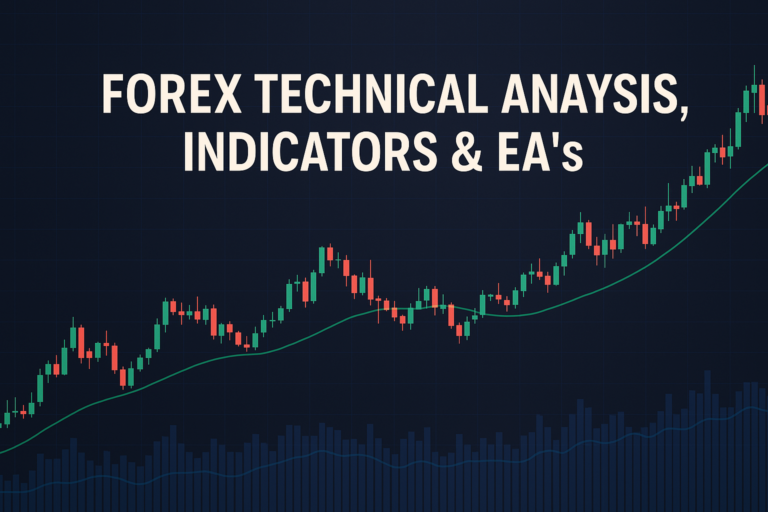
The Bollinger Band Mean Reversion Strategy is a valuable tool for Forex traders seeking to understand market dynamics better and improve their trading outcomes.
The Bollinger Band Mean Reversion Strategy is a fascinating tool in Forex trading. Picture it as a safety net that helps traders identify when prices may return to their average level. This strategy uses Bollinger Bands, which are like elastic bands around prices. When prices stretch too far, they often bounce back. This is where the magic happens! Traders can spot these movements and make informed decisions.
However, many traders, both beginners and seasoned professionals, often struggle with this strategy. The reason? Understanding how to read the bands and predicting price movements can be tough. Traders might jump in too early or miss out on opportunities. That’s why grasping the Bollinger Band Mean Reversion Strategy is crucial for success in Forex trading. It can help traders make smarter choices and avoid costly mistakes.
This article will take you on a journey through the Bollinger Band Mean Reversion Strategy, breaking it down into simple concepts. We’ll explore its history, advantages, and disadvantages, and even share strategies you can use in your trading.
Before diving deeper, let’s touch on a related topic: Order Duplication. It’s important to understand how order duplication can affect your trades and why you should manage it carefully.
What is a Bollinger Band Mean Reversion Strategy?
The Bollinger Band Mean Reversion Strategy is a way to predict price movements based on the average price over time. Imagine you’re bouncing a ball. Sometimes it goes high, sometimes it goes low, but it tends to return to your hand. In trading, we look for similar behavior in prices. When prices are above the upper band, they may drop back down. When they are below the lower band, they might rise again. This strategy helps traders identify when to buy or sell based on these price movements.
Types of Bollinger Band Mean Reversion Strategy
There are different types of Bollinger Band Mean Reversion Strategies. Here are a few:
- Simple: This is the basic version where traders buy when prices hit the lower band and sell at the upper band.
- Exponential: This type gives more weight to recent prices, making it more responsive to price changes.
- Weighted: This strategy uses weighted averages, helping to smooth out price fluctuations.
How the Bollinger Band Mean Reversion Strategy Smooths Out Price Action
The Bollinger Bands smooth out price action by using moving averages. These averages help filter out the noise of random price fluctuations. When you look at a chart, you’ll see the bands adjusting based on the average price over a set period. This makes it easier to spot trends and reversals, allowing traders to make better decisions.
Common Periods Used and Why
Traders often use common periods like 20, 50, or even 100 days for their Bollinger Bands. A 20-day period is popular because it balances short-term movements with longer trends. This makes it easier to identify when prices are stretched too far from the average. Choosing the right period is essential for effective analysis.
The History of Bollinger Band Mean Reversion Strategy: How It Became Popular
Origin of Bollinger Band Mean Reversion Strategy
The Bollinger Band Mean Reversion Strategy was created by John Bollinger in the 1980s. He wanted to develop a tool that would help traders understand market volatility better. By using moving averages and standard deviations, he created the bands that traders use today. His goal was to provide a visual representation of price movement, making it easier to trade.
When Did Traders Start Using It Widely?
As the digital age took off in the 1990s, traders began to adopt the Bollinger Band Mean Reversion Strategy widely. With the rise of online trading platforms, more traders had access to technical analysis tools. The strategy gained popularity because it was straightforward and effective, helping many traders improve their trading results.
Real-Life Stories
Many professional traders have shared their success stories using the Bollinger Band Mean Reversion Strategy. For example, a trader named Sarah started using this strategy and saw her profits double in just a few months. By understanding the bands and when to enter or exit trades, she was able to make informed decisions that led to her success.
Advantages and Disadvantages of Bollinger Band Mean Reversion Strategy
Advantages:
Here are some advantages of using the Bollinger Band Mean Reversion Strategy:
- Helps Identify Trends Easily: The bands visually show trends, making it easier for traders to spot opportunities.
- Useful for Dynamic Support and Resistance: The bands act as support and resistance levels, helping traders make decisions.
- Works Well for Crossover Strategies: The strategy can be combined with other indicators for better results.
Disadvantages:
Even though this strategy has advantages, it also has its drawbacks:
- Lags Behind Price Movements: The strategy can be slow to react to sudden price changes, leading to missed opportunities.
- Can Give False Signals in Sideways Markets: In flat markets, the bands may not provide reliable signals, causing confusion for traders.
How to Apply Bollinger Band Mean Reversion Strategy on MT4 & MT5
Step-by-Step Guide to Adding Bollinger Band Mean Reversion Strategy on Charts
To apply the Bollinger Band Mean Reversion Strategy on MT4 or MT5, follow these steps:
- Open your trading platform.
- Select the currency pair you want to analyze.
- Click on “Insert,” then “Indicators,” and select “Trend” to find Bollinger Bands.
Customizing Bollinger Band Mean Reversion Strategy Settings
Once you’ve added the Bollinger Bands, you can customize the settings. Adjust the periods, colors, and types according to your preferences. For example, you might want to set the period to 20 and choose colors that are easy to see on your chart.
Saving Templates for Easy Application
After customizing your Bollinger Bands, save the template for easy application in future trades. This way, you won’t have to set everything up again. Just click “Templates,” then “Save Template,” and give it a name!
5 to 7 Trading Strategies Using Only Bollinger Band Mean Reversion Strategy
All Time Frame Strategy (M5 to D1)
This strategy works across all time frames, from M5 to D1. Traders look for price touching the bands to enter trades. For example, if the price touches the lower band, they might buy, expecting a bounce back.
Trending Strategies
In trending markets, the strategy can be adjusted. Traders can look for entries when the price pulls back to the middle band before continuing in the trend direction. This helps them ride the trend effectively.
Counter Trade Strategies
This strategy focuses on counter-trend movements. When the price hits the upper band, traders may sell, anticipating a return to the middle band. It’s about capitalizing on overbought conditions.
Swing Trades Strategies
Swing traders use the Bollinger Bands to catch price swings. They look for price reversals at the bands, entering trades when they see signs of a bounce. This strategy can be rewarding if done correctly.
5 to 7 Trading Strategies Combining Bollinger Band Mean Reversion Strategy with Other Indicators
All Time Frame Strategy (M5 to D1)
Traders can enhance their Bollinger Band strategy with other indicators like RSI. For example, if the price touches the lower band, but the RSI shows oversold, it’s a strong buy signal.
Trending Strategies
Combining Bollinger Bands with moving averages can help confirm trends. When the price is above the moving average and touches the upper band, it may indicate a strong trend continuation.
Counter Trade Strategies
Using Bollinger Bands with MACD can provide additional confirmation. If the price hits the upper band and the MACD line crosses below the signal line, it may be a good time to sell.
Swing Trades Strategies
When using the Bollinger Bands with Stochastic Oscillator, traders can spot potential reversals. If the price is at the lower band and the Stochastic shows oversold conditions, it could be a good buy opportunity.
Speaking of currency pairs, you might want to check out the journey of trading 369 GBP to USD as it offers insights into trading strategies.
Top 10 FAQs About Bollinger Band Mean Reversion Strategy
1. What are Bollinger Bands?
Bollinger Bands are indicators that consist of three lines: a middle line (moving average) and two outer bands representing standard deviations. They help traders identify price volatility.
2. How do I use Bollinger Bands for trading?
Traders use Bollinger Bands to identify potential buy and sell signals based on price action relative to the bands. Buying occurs near the lower band, while selling happens near the upper band.
3. Can Bollinger Bands be used in all markets?
Yes! Bollinger Bands can be applied to any market, including stocks, Forex, and commodities. They are versatile tools for traders.
4. What is the best setting for Bollinger Bands?
The most common setting is a 20-period moving average with standard deviations set to 2. However, traders can adjust these settings based on their trading style.
5. How do I avoid false signals with Bollinger Bands?
To reduce false signals, combine Bollinger Bands with other indicators like RSI or MACD to confirm buy and sell signals.
6. Are Bollinger Bands effective for day trading?
Yes! Many day traders use Bollinger Bands to identify quick price movements and make trades based on short-term volatility.
7. Can I use Bollinger Bands on longer time frames?
Absolutely! Bollinger Bands can be applied to longer time frames like daily or weekly charts. They help identify long-term trends and reversals.
8. What is the main disadvantage of Bollinger Bands?
The main disadvantage is that they can lag behind price movements, leading to missed opportunities during rapid price changes.
9. How do I incorporate Bollinger Bands into my trading strategy?
Start by using Bollinger Bands in combination with other indicators. Set clear entry and exit points based on price action and band behavior.
10. Are there any specific market conditions where Bollinger Bands work best?
Bollinger Bands work best in trending and volatile markets. They can provide clearer signals during these conditions, making it easier to identify opportunities.
Conclusion
The Bollinger Band Mean Reversion Strategy is a powerful tool for traders at any level. By understanding how to use it effectively, you can enhance your trading skills and make more informed decisions. Remember to practice these strategies in a demo account before risking real money.
As you explore the world of Forex trading, don’t forget to test different strategies and find what works best for you. The key is to learn, adapt, and grow as a trader!
Looking to go beyond the basics? This resource offers deeper insights XE Currency, Benzinga
Expand Your Knowledge
- 📌 Forex Trading Learning Road Map
- 📌 Forex Trading Course with no Fees
- 📌 Forex Trading Issues, Problems, and Solutions
- 📌 Forex Daily Forecast & Live Updates
- 📌 Forex Fundamental & News Analysis: Tomorrow’s Market Movers & Trade Opportunities
- 📌 Forex Education Hub: Learn & Profit
- 📌 Forex Technical Analysis, Indicators & EA’s
Start Trading Today
Ready to take your forex trading to the next level? Open an account with Exness, one of the most trusted platforms in the industry. 👉 Sign Up Now and trade with confidence!
My recommended broker stands out with ultra-low spreads for beginners, instant withdrawals, and zero spread accounts for pro traders.
Trusted since 2008, lightning-fast execution, no hidden fees, and a secure, transparent trading environment—giving you the edge you need to succeed. 🚀
YouTube Video Library: Related Videos
Note: The video above is embedded from YouTube and is the property of its original creator. We do not own or take responsibility for the content or opinions expressed in the video.




